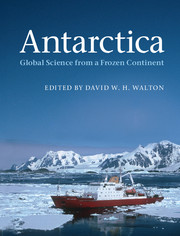Book contents
- Frontmatter
- Contents
- List of contributors
- Introduction
- 1 Discovering the unknown continent
- 2 A keystone in a changing world
- 3 Ice with everything
- 4 Climate of extremes
- 5 Stormy and icy seas
- 6 Life in a cold environment
- 7 Space science research from Antarctica
- 8 Living and working in the cold
- 9 Scientists together in the cold
- 10 Managing the frozen commons
- 11 Antarctica: a global change perspective
- Appendix A Visiting Antarctica
- Appendix B Further reading
- Acknowledgements
- Index
3 - Ice with everything
Published online by Cambridge University Press: 05 March 2013
- Frontmatter
- Contents
- List of contributors
- Introduction
- 1 Discovering the unknown continent
- 2 A keystone in a changing world
- 3 Ice with everything
- 4 Climate of extremes
- 5 Stormy and icy seas
- 6 Life in a cold environment
- 7 Space science research from Antarctica
- 8 Living and working in the cold
- 9 Scientists together in the cold
- 10 Managing the frozen commons
- 11 Antarctica: a global change perspective
- Appendix A Visiting Antarctica
- Appendix B Further reading
- Acknowledgements
- Index
Summary
Where does the strange attraction to the polar regions lie, so powerful, so gripping that on one's return from them one forgets all the weariness of body and soul and dreams only of going back? Where does the incredible charm of these unattended and terrific regions lie?
Jean-Baptiste Charcot, 1908For many people the word Antarctica is synonymous with cold and with more ice than can be imagined. The Antarctic continent has been continuously covered by a thick layer of ice for the past 15 million years, leaving less than 0.5% of the underlying rock visible. This enormous mass of ice, formed by the progressive accumulation of snowfall, slowly flows back to the ocean. Antarctica is a major actor in our global climate system as well as being a most precious archive of the history of climate evolution over the last 1 million years.
Antarctic ice in the global water cycle
For many millions of years, Antarctica has been the largest reservoir of continental ice on earth. The dimensions of this ‘sleeping giant’ are astonishing. The area permanently covered by continental snow and ice is greater than 13 million km², 30% more than all of Europe. Around Antarctica, the cold Austral Ocean enhances the ice area every winter as the frozen surface waters form sea ice. These ice surfaces reflect sunshine back into space rather than absorbing it, helping to maintain extremely cold conditions at the high southern latitudes.
- Type
- Chapter
- Information
- AntarcticaGlobal Science from a Frozen Continent, pp. 67 - 101Publisher: Cambridge University PressPrint publication year: 2013



